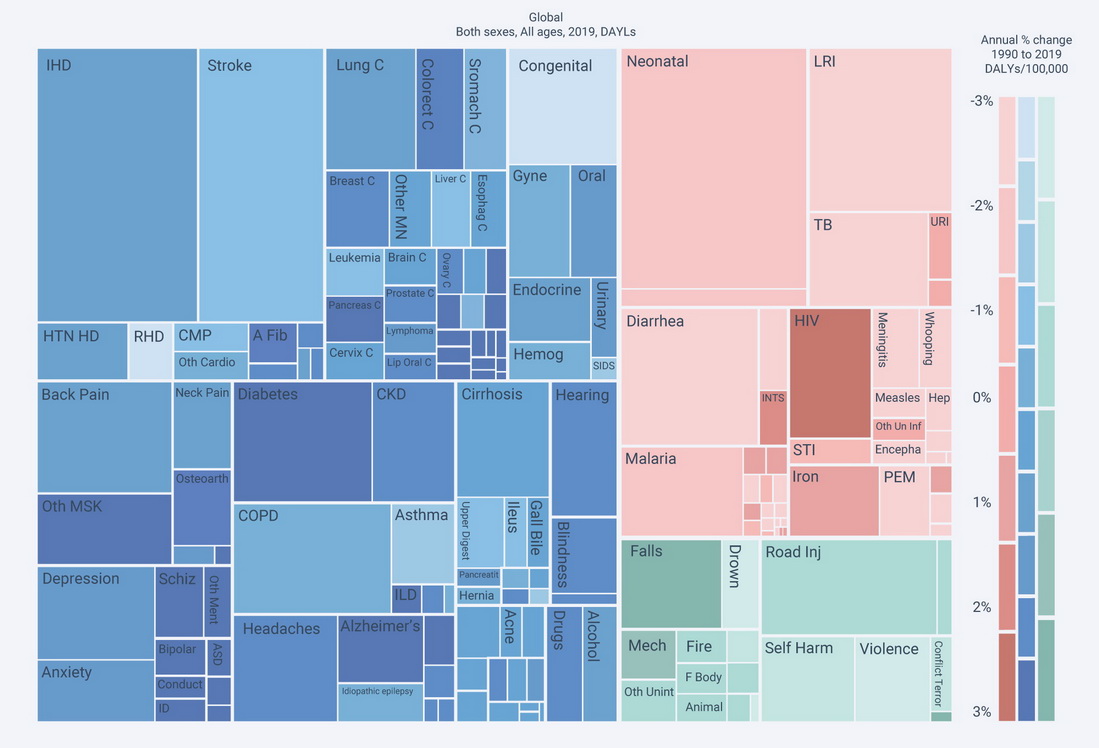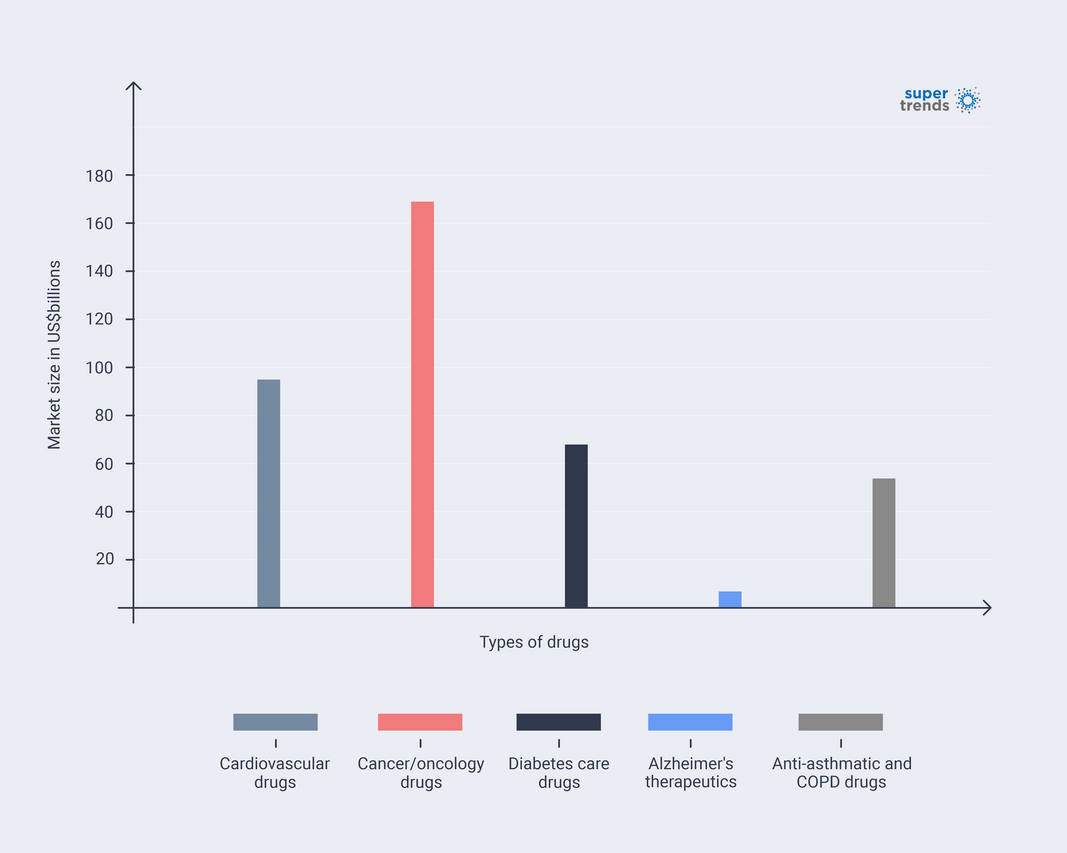With a rapidly aging population, age-related diseases are the leading causes of global death, as well as causing more than half of all global disease burdens (calculated by financial cost and other indicators). Arguably, anti-aging therapeutics offer the biggest market opportunity in the healthcare industry. However, the market opportunities will be different in the short term versus the longer term.
Aging and the mordent healthcare system
Aging is a major risk factor for cardiovascular disease, chronic obstructive pulmonary disease, cancer, neurodegenerative disease such as Alzheimer’s and Parkinson’s disease, and type-2 diabetes.4 In 2020, six of the top ten leading global causes of death were age-related.5
When measured in terms of disease burden, the financial cost of a health problem, mortality, morbidity, and other indicators, the age-related disease burden accounted for more than half of all global burden in 2017.6

Age-related diseases share common biological mechanisms. Therefore, anti-aging technology can target potentially all age-related diseases and transform the way we treat major diseases.
Market opportunity – short-term
Today, aging is not categorized as a disease by any regulatory agency. Almost all anti-aging therapeutics currently being developed are targeted at age-related diseases in the immediate term. These therapeutics will possibly be targeting aging itself in the longer term.
In 2019, the combined market size for drugs that treat the five most common age-related diseases is US$389.52 billion. The market size for each disease is growing at an annual speed between three and ten percent. 7,8,9,10,11

Market opportunity – long-term
Metformin and Rapamycin were the first two drugs to target aging in clinical trials. Both are FDA-approved drugs that are re-purposed for aging. In the longer term, new therapeutics will be directly target aging. When that happens, literally every middle-aged and elderly adult will be a potential consumer.
The global population aged 60 years or over is 607.1 million in 2000. This number is projected to more than double to 1.4 billion in 2030 and reach 2.09 billion in 2050. More than half of the older population already lives in Asia.12


Although the size of the older population is increasing in every country, more and more older people will soon live in upper-middle-income and lower-middle-income countries.13
Which age group has the highest risk of developing age-related diseases? Take heart disease and stroke, the two most common age-related diseases, as examples. The age group that is more likely to suffer from cardiovascular disease14 is people aged over 65. In the case of stroke, most patients are aged over 55.15 If we consider the age group of 60-year-olds and over to be the primary customer group of anti-aging therapeutics, we are looking at a customer base that is close to one billion and growing rapidly. Many researchers support the idea of applying anti-aging interventions from middle age, which further widens the customer group.
Geographically, the customer base will be located across all regions, with Asia and middle-income countries having the most potential customers. Few other products can reach such a huge customer base.
References
4. Franceschi C, et al. The Continuum of Aging and Age-Related Diseases: Common Mechanisms but Different Rates. Front Med (Lausanne). 2018; 5:61. doi:10.3389/fmed.2018.00061
5. World Health Organization. The top 10 causes of death. 2020. https://www.who.int/news-room/fact-sheets/detail/the-top-10-causes-of-death
6. Chang AY, et al. Measuring population ageing: an analysis of the Global Burden of Disease Study 2017. Lancet Public Health. 2019 Mar;4(3):e159-e167. doi: 10.1016/S2468-2667(19)30019-2.
7. Fortune business insights. Market research report cardiovascular drugs market. 2019. https://www.fortunebusinessinsights.com/industry-reports/cardiovascular-drugs-market-100379
8. Globe newswire. Oncology market size 2020 particularly prone to disruption during pandemic in the global oncology market. 2020. http://www.globenewswire.com/fr/news-release/2020/10/06/2104100/0/en/Oncology-Market-Size-2020-Particularly-Prone-To-Disruption-During-Pandemic-In-The-Global-Oncology-Market.html
9. Mordor intelligence. Diabetes care drugs market. 2020. https://www.mordorintelligence.com/industry-reports/diabetes-drugs-market
10. Medgadget. Alzheimer’s therapeutics market to reach USD 13.57 billion by 2027. 2021. https://www.medgadget.com/2021/01/alzheimers-therapeutics-market-to-reach-usd-13-57-billion-by-2027-size-share-industry-analysis-and-global-forecast-to-2027.html
11. Globe newswire. Anti-asthmatics and COPD drugs global market report 2020-30. 2020. https://www.globenewswire.com/news-release/2020/09/24/2098954/0/en/Anti-Asthmatics-And-COPD-Drugs-Global-Market-Report-2020-30-Covid-19-Implications-and-Growth.html#:~:text=The%20global%20anti%2Dasthmatics%20and,billion%20in%202019%20to%20%2477.&text=3%20billion%20in%202020%20at,to%20the%20COVID%2D19%20outbreak.
12. United Nations. World Population Ageing 2017 Highlights. 2017. https://www.un.org/en/development/desa/population/publications/pdf/ageing/WPA2017_Highlights.pdf
13. United Nations. World Population Ageing 2017 Highlights. https://www.un.org/en/development/desa/population/publications/pdf/ageing/WPA2017_Highlights.pdf
14. National Institute on Aging. Heart Health and Aging. https://www.nia.nih.gov/health/heart-health-and-aging#:~:text=Adults%20age%2065%20and%20older,risk%20of%20developing%20cardiovascular%20disease.
15. Johns Hopkins Medicine. Risk Factors for stroke. https://www.hopkinsmedicine.org/health/conditions-and-diseases/stroke/risk-factors-for-stroke